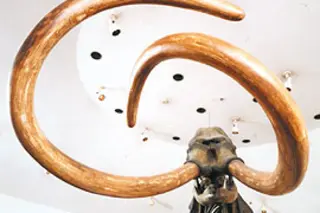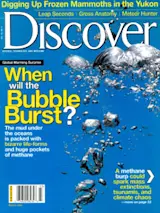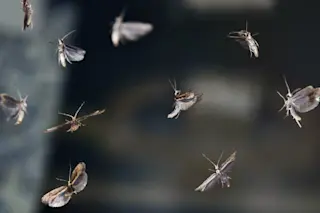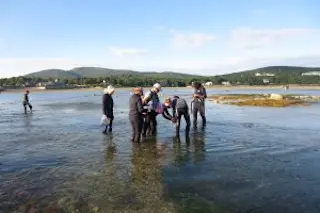The road to the Irish Gulch gold mine is rugged and winding. To get there, you head south out of Dawson, in Canada’s Yukon Territory, then bear right at the sign for GuggieVille, an RV park named after the Guggenheim family of New York. (The Guggenheims once managed a gold-dredging operation here.) From there, a washboard gravel road leads past a slew of small mines—the Lucky Lady, Last Chance, and Gold Run—then dead-ends at Irish Gulch.
The North American megafaunal extinction, as the event is known, was not an isolated incident. At various times, sudden, sweeping die-offs have been recorded in Madagascar, New Zealand, Australia, and South America. Unlike the meteor that hastened the demise of dinosaurs 65 million years ago, the North American megafaunal extinction has not been linked to a single cataclysm. Disease is one suspect, as are rapid climate changes and global warming. But the most popular scenario is simpler and bloodier: The megafauna were hunted to death by bands of humans that crossed the land bridge behind them.
Many paleontologists have argued that the people who crossed the land bridge into North America were too few and poorly armed to wipe out mammoths and scimitar-toothed cats. But Cooper, until recently, disagreed. He grew up in New Zealand, where he spent most of his youth spelunking through caves. On occasion, he would run across the remains of moas, extinct birds that once populated the country. Moas were tall, flightless, and evidently tasty: In the space of 300 years, the native Maori had wiped them out. “You find barbecue pits full of their bones,” Cooper says. “So I wasn’t stopped by the idea that these guys had primitive weapons.”
As it happens, moas were also the subject of Cooper’s first foray into ancient DNA: He spent a year in the late 1980s working on them at the University of California at Berkeley, when paleogenetics was still an embryonic field. Cooper first compared moa and kiwi DNA to see if the two flightless birds were closely related. Much to everyone’s surprise, they were not. Then he took a closer look. Taxonomists had long divided moas into two types, one of which, Dinornis, included three species: a 5-foot-tall bird, a 3-foot dwarf, and a 10-foot-tall, 550-pound “supermoa.” The bones of all three groups covered New Zealand, but after cloning and comparing their DNA, Cooper made a startling discovery: All three species were genetically identical. The so-called dwarf moa was actually the male, and the two taller birds were female. “Here we had thousands of bones of birds that went extinct only 500 years ago, and no one worked out that we were looking at males and females until we compared the DNA,” Cooper says. “Think of early human ancestors, where we have only scattered fossil fragments, and the problem of relying on morphology is obvious.”
In the post-Jurassic Park era, Cooper’s work attracted attention. In recent years, he has been contacted by a museum with access to Captain Cook’s leg bone, a plumber with a plan to bring back the dodo, and a couple of elderly Italians who wanted to clone their dead cats. There was also talk of recovering DNA from Jesus’ foreskin, bits of which were supposedly preserved in various churches around Italy. “Did you know that his foreskin was four feet in diameter?” Cooper says. “That’s what you get if you combine all the holy relics.”
Still, the Berkeley results became a landmark for Cooper—a crucial sign that “the molecules were giving the right answer.” Four years later, he was given a book about the Ice Age and, as he puts it, “twigged to the possibilities of permafrost.”
Cooper is something of an anomaly in his field. He was the youngest person ever awarded a titular professorship of zoology at Oxford, and at 38 he is still half the age of the grand old men who dominate paleontology. He has an athlete’s build and lanky brown hair that he habitually tosses back. He talks fast, swears often, and has a manner both droll (he keeps a collection of Pleistocene bones in his bidet) and flamboyant. At one mine we visited, he climbed so high under a rotten overhang that his students jokingly asked if he had at least left them the keys to the Jeep.
As a scientist, Cooper is known for pouncing on appealing projects. He runs one of the world’s premier facilities for studying ancient DNA—Oxford University’s Henry Wellcome Ancient Biomolecules Centre—and his publishing schedule verges on maniacal. While most researchers are lucky to get a single paper accepted into the journals Nature and Science, Cooper and his teams average four a year. In 2003 alone, Cooper reported on subjects ranging from dodoes to the genetic origins of Andaman Islanders, to what kind of bacteria NASA ought to look for on Mars. Last spring, he and a colleague, Eske Willerslev, created an uproar when they managed to recover 20,000- to 30,000-year-old mammoth, horse, and musk ox DNA from a clod of frozen Siberian dirt. Such success has not always endeared him to paleontology’s conservative elite. “Cantankerous old bastards,” Cooper calls them cheerfully. “Fortunately, they’re dying off.”
This is his fourth year in Dawson. When I arrived, he was shuffling around the porch of the White House Motel in jeans and a tatty pair of beaded moccasins. For the past few years, Cooper has been plotting out Beringia’s phylogeography: a reconstruction of which animals were where and when, based on differences in their DNA. Against this backdrop, the events of the megafaunal extinction should stand out. Extinctions, Cooper says, leave a genetic signature—a pattern of changes over time that can be analyzed, the way a forensic detective can discern whether a victim was drowned, or killed first and dumped in a lake. “When a species begins to lose its habitat, as happened when Earth warmed up and the grasslands turned into forests, what you see is a steady dwindling of genetic diversity,” he says. “That’s different from the sharp drop you’d see if the animals were simply hunted down en masse.”
To expose this genetic signature, Cooper needs a large number of bones, all from a single species—preferably distributed over thousands of years. That rules out large carnivores (too scarce) and mammoths (ditto). Bison fossils, on the other hand, are abundant. “The cockroaches of the Pleistocene,” Cooper calls them. “If humans did cross the land bridge 40,000 years ago, they would have been pushing their way through the bloody things.”
Nevertheless, there is still the problem of finding bones with intact DNA. The older a bone is, the more likely its DNA is badly degraded. Thawing out a specimen only accelerates the damage. Ideally, a fossil has to be found before it defrosts, and hopefully it’s still embedded in the original ice. Earlier in the day, one of Cooper’s graduate students had recovered a 30,000-year-old horse tibia so well preserved that it still contained marrow and liquid fat. “It was so creamy,” another student raved, rummaging through the bags of bones stored in the motel freezer, alongside a box of veggie burgers that appeared to be nearly as ancient.
Unwrapped, the tibia looked oily and eerily fresh, despite a small trapezoidal hole midway along its shaft. “That’s the piece we’ll be taking home,” the student explained, pointing to an excised eraser-size nub. Because even a small scrap of bone contains billions of copies of an animal’s genes, carting home a whole femur is senselessly redundant. Instead, each specimen is whittled down to a half-inch sample and kept frozen. Later, at the lab the sample is placed in a container with steel ball bearings and shaken until ground to a powder. “After an animal dies, the cells are basically entombed in the calcium matrix of the bone,” Cooper says. “To get the DNA out you have to break up the matrix, dissolve the cell wall, and then sift the genes out of the wreckage. It’s like having to demolish a whole building to get at the contents of just a few rooms.”
Researchers then multiply small sections of the genetic flotsam using a technique called PCR, or polymerase chain reaction. PCR lets researchers make millions of copies of a single genetic fragment, but it works faster on DNA in good condition: Each point of damage in the genetic sequence slows the reaction down. Because ancient DNA is almost always badly damaged, its signal is easily swamped by even a speck of more modern contaminants—anything from bacteria that invaded the bone after death to the roast beef sandwich residue on a researcher’s hands. Labs that handle ancient specimens often handle more recent PCR samples as well, but the latter contain inordinately greater amounts of DNA. “Get one-trillionth of a drop of that on your clothing, and the contaminating DNA will still be a million times more abundant than the DNA from your specimen,” Cooper says.
For a few years in the early 1990s, the contamination problem was so acute that it nearly brought down the field. Eager to stake a claim in the burgeoning science, researchers raced to extract DNA from any ancient object they could find. A slew of remarkable papers quickly followed: Analyses were reported of DNA from a 7,000-year-old human brain, a dinosaur, and a 23-million-year-old insect preserved in amber. Although a few findings proved reproducible, most were embarrassingly debunked. For instance, the renowned paleobiologist Svante Pääbo, then at the University of California at Berkeley, claimed to have recovered nuclear DNA from an Egyptian mummy. Follow-up experiments showed that the mummy’s DNA was probably Pääbo’s own.
To win the confidence of the scientific community, Cooper needed a meticulously controlled environment. So while still a postdoctoral student at Oxford, he wrangled a $2 million grant from the Wellcome Trust and the British government to build a state-of-the-art laboratory. Completed last June, the Ancient Biomolecules Centre keeps a computer registry of all its employees’ DNA, drawn from hair samples. Its researchers work in disposable Tyvek coveralls, booties, shower caps, and gloves. As a final prophylactic measure, the entire building is maintained at positive pressure: Should a door accidentally open, the lab’s air will rush out, but the outside air won’t seep in.
This past summer, Cooper and graduate student Beth Shapiro revealed the results of their bison study at the Third International Mammoth Conference, in Dawson. Compared with recent studies of mammoths found in the Siberian ice fields, the bison study seemed somewhat unglamorous. By paleobiology standards, however, the results were exotic. Cooper and Shapiro recovered DNA samples from more than 400 bison and entered those sequences, with their radiocarbon dates, into a modeling program. Developed to track the evolution of viruses like hepatitis and HIV, the program uses pieces of salvaged DNA to create a genetic family tree. Joins on the tree, known as coalescence points, mark the time at which two family lines diverged—or, traveling into the past, the point at which two lineages “coalesce” back into a common ancestor.
The frequency of the coalescence points goes down as the number of bison goes up. (Roughly, the more bison there are, the greater their genetic diversity and the longer it will take to find the common ancestor of two animals chosen at random—just as one would expect residents of a small English village to be more closely related than two people picked at random from the world population.) Had the bison actually been hunted to death, as Cooper first believed, there would have been a rapid population drop-off around 12,000 years ago. Instead, the number of bison peaked about 30,000 years ago, then tanked spectacularly. From highs of tens of millions of bison, the breeding population dropped to hundreds at most. For Cooper, this was baffling not just because the bison were dying earlier than expected but because they were dying for no apparent reason—some 10,000 years before the brutal cold of the glacial maximum and some 20,000 years before the first known humans arrived. “Even if there were humans—and I wouldn’t be surprised if there were a few of them—we’re talking about a population of 10 million bison, which is bloody huge,” Cooper says. “There’s no way people could have done that kind of damage without leaving some pretty major archaeological signs. If they were driving them over a cliff or something, you’d find masses of bones at the bottom. But there’s no sign of anything like that.”
As Cooper sees it, the most likely culprit was climate—though the effects now appear to have occurred much earlier than expected. “This is not a time of extreme heat or cold, as you’d think,” he says. “Something subtler in the lead-up, such as increasing aridity and changes in vegetation, may be doing the damage.” Interestingly, the timing of the bison die-off matches another mysterious disappearance: the vanishing of Beringia’s brown bears. “There’s clearly something severe going on in the environment at this point,” Cooper says. “But so far, neither the climatologists nor the paleontologists have identified it.” It’s possible, he adds, that the few survivors, unlike some of the other megafauna, were genetically diverse enough to adapt to their new circumstances. Then humans showed up. “Humans were probably the nail in the coffin,” he says. “But it was climate that created this dead-man-walking situation, with diversity so buggered that the animals were just ready to be knocked over.”
Not every biologist agrees. Some believe that humans infected Beringia with a virulent, species-crossing disease, although no one has found clear evidence of it. Paleontologist Paul Matheus of the Alaska Quaternary Center at the University of Alaska has a broader complaint. “With ancient DNA, the flash factor is high,” he says. “There are biologists who’ve spent their lives studying the local ecology and biology, and these geneticists’ ideas don’t always agree with what we’ve found. You have to be careful or you end up with an oversimplified view of how these systems work. At worst, the attitude is, if the DNA says it, it must be true.”
Even detractors agree that Cooper is obsessed with accuracy. But ancient DNA results are notoriously tricky. Cooper recently conducted a study of Viking DNA that showed many of them to be of Middle Eastern descent, an impossible result. By tracing the problem, he discovered that the DNA extracted from the Vikings had mutated consistently at a key point that geneticists use to determine a person’s ancestry—in this case, the splitting point for Middle Eastern and European lineages.
Cooper’s efforts are more than an academic exercise. Given that our own changing climate is hotly debated, the fate of the ancient megafauna could help clarify the future as well as the past. Thirty thousand years ago, Cooper says, animals could respond to environmental changes by migrating. These days they are increasingly hemmed in by human development, so future temperature shifts are likely to cause even more rapid extinctions. In the meantime, Cooper is analyzing Beringian horse DNA to see whether it matches the bison results. The two species have only slightly different ecological needs, so comparing them should give a better idea of what killed them off. “It’s a bit twisted, really,” he concludes. “On the one hand, it looks like humans didn’t carry out the slaughter we thought they had. On the other hand, climate change seems to cause problems much earlier than anyone thought.”
Imagine what paleobiologists 10,000 years from now will say when they look back on our world.
The Dogs Ate His Homework
Two years ago, Jim Christie was excavating his family claim using a two-story backhoe when an overhanging face collapsed, exposing the mummified carcass of a prehistoric bison. Given the body’s bedraggled condition, it would have been easy to mistake it for a jumble of sticks, but the bison was not the first animal to wash out of the Christie Mine. Mud-stained bones melt free every season; one year, the family even found a woolly mammoth tusk.
Mammoth ivory is prized by carvers, and a similar tusk was recently auctioned for $50,000. (Trade in mammoth ivory is legal because woolly mammoths are extinct and therefore not at risk of becoming endangered.)
Mummified bison don’t have the same cachet, and to make matters worse, they stink. Still, Jim’s daughter Tara guessed the bison might have scientific value. She bagged the remains and stowed them in the freezer, but they were bulky, so she later moved the carcass outside. With temperatures hovering around –20°F, there was no danger of the thing defrosting. Not long afterward, however, a pack of wolves discovered the body, tore through several layers of plastic wrap, and chewed the shriveled animal to bits.
This turned out to be more than unlucky. Mummies are rare, but the bison—which had fallen out of a 200,000-year-old stratum of ice—was later revealed to be the oldest ever found in North America. “Everyone would have wanted it,” paleobiologist Alan Cooper says. In his view, the fact that wolves were drawn to the bison by smell, and actually ate the meat, meant that it must have been incredibly well preserved. “Two-hundred-thousand-year-old meat!” he adds grimly. “It must have been a long night for those dogs.”
—J. K.






